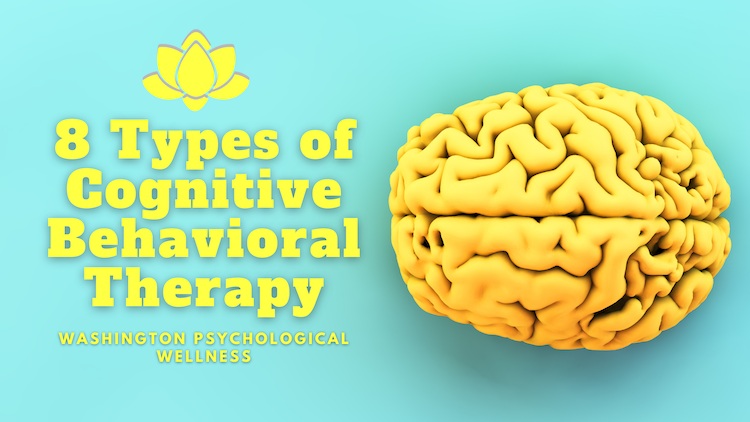
The 8 Types of Cognitive Behavior Therapy
Rather than a specific type of therapy, Cognitive Behavior Therapy (CBT) is better understood as an umbrella term. Many of the approaches that fall under the CBT umbrella focus on understanding the interaction between one’s thoughts, feelings, and behaviors. A CBT therapist works to help clients assess, recognize, and deal with problematic and dysfunctional ways of thinking, feeling, and behaving. 8 types of cognitive behavioral therapy
Generally speaking, CBT tends to be goal-oriented and short-term. However, the length of treatment depends on various factors, including the severity of symptoms and consistency of treatment compliance, and practiced learned therapy skills between sessions. Depending on the specific type of CBT, different interventions may be used.
The following evidence-based interventions fall under the CBT umbrella and have successfully treated numerous mental health conditions, including anxiety, depression, alongside others.
Cognitive Therapy is one of the earliest therapies to be considered CBT. It focuses on identifying and changing the unhelpful or distorted thinking patterns commonly experienced by individuals suffering from depression. Cognitive Therapy utilizes collaborative elements like agenda-setting and homework assignments between sessions, emphasizing the correction of cognitive distortions or thinking errors as well as maladaptive behaviors.
Dialectical Behavior Therapy (DBT) was developed by Dr. Marsha Linehan and is heavily based on CBT with one exception: it highlights validating or accepting uncomfortable thoughts, feelings, and behaviors instead of fighting them. By accepting and coming to terms with discomfort, DBT encourages change through a mindful and present stance. Initially designed to treat individuals with Borderline Personality Disorder (BPD), DBT is one of the most commonly utilized treatment interventions today. Anyone who frequently experiences extreme, unpredictable, negative emotions can benefit from DBT.
Motivational Interviewing (MI) is an evidence-based approach that is directive and goal-directed. MI recognizes that people start therapy with varying levels of commitment and willingness to change. Motivational Interviewing facilitates the internal motivation needed for behavior change while resolving any existing ambivalence towards change. Although initially developed to help people overcome substance use problems, MI is now used to explore and enhance motivation for changing almost any behavior.
Acceptance and Commitment Therapy (ACT). The central premise of ACT is that people’s thoughts and feelings are affected by events, the people around them, and their environment. ACT focuses on increasing tolerance for emotional pain, especially when avoiding pain prevents one from living a fulfilling and meaningful life. ACT promotes alternative ways to cope with and relate to emotional pain while clarifying a person’s values. Techniques from ACT help individuals get “unstuck” from their emotions so they can pursue more value-consistent actions.
Rational Emotive Behavior Therapy (REBT) involves identifying irrational beliefs, actively challenging these beliefs, and recognizing and changing maladaptive thought patterns. Albert Ellis created REBT based on the idea that each person holds a unique set of basic assumptions about themselves and the world, influencing their actions and reactions and influencing their perspective on situations.
Mindfulness-Based Stress Reduction (MBSR). MBSR utilizes the principles of mindfulness meditation to manage stress and related symptoms. Although it’s primarily used in treating anxiety-related disorders and chronic pain, those who don’t have a diagnosis may find MBSR beneficial as they can learn to manage stress much more effectively.
Mindfulness-Based Cognitive Therapy (MBCT). MBCT is a relatively new form of CBT riding the crest of its third wave is Mindfulness-Based Cognitive Therapy (MBCT). The essential element of MBCT is mindfulness. The focus doesn’t lie on changing thoughts like in other forms of CBT, but rather the way a person reacts to these thoughts. Research suggests that those who live with a significant amount of stress, anxiety, or chronic pain can benefit from MBCT. The goal is to help people make healthy choices with each new day and improve life on a moment-to-moment basis.
Exposure Therapy. Exposure therapy is a type of cognitive-behavioral treatment most frequently used to treat OCD, PTSD, and phobias. Through treatment, a person and their therapist work together to identify anxiety triggers and learn relaxation techniques to manage anxiety-induced distress. In a controlled, safe environment, the person would then confront those triggers while simultaneously implementing relaxation techniques. While some can encounter distressing memories at once or via flooding, others need to work up to them over time to avoid re-traumatization. In this case, a therapist will help ease one into the exposure process by leveraging relaxation techniques, typically starting with the more manageable memories.
Getting Started With Cognitive Behavioral Therapy
While each type of cognitive-behavioral therapy takes a different approach, all work to address the underlying thought patterns that contribute to psychological distress. Treatment progress is dependent on each individual’s unique circumstances and needs. You and your therapist will actively check in to ensure that progress is being maintained and that your treatment goals, values, and hopes are being accomplished.
At Washington Psychological Wellness, we actively work with and consult with outside providers, teachers, clergy, and family members to coordinate care. If you’d like to learn more about CBT and how it can help you achieve holistic mental wellness, contact us at Washington Psychological Wellness today.
Related Content
The Benefits of Cognitive Behavioral Therapy (CBT) For Children
